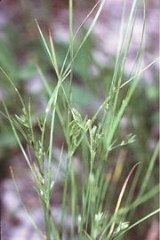
Slender rush
Encyclopedia
Juncus tenuis, the Slender Rush, is a clump-forming, round-stemmed perennial in the Juncaceae
(rush family
). Slender rush grows to be between 15 and 60 cm tall. Generally considered a weed
, it is rarely sold by retailers as a household container plant. Where it is introduced, it is colloquially called Path Rush, Field Rush, Slender Yard Rush or (quite ambiguously) "wiregrass
".
The leaves
of the plant all come from the base and are not nearly as tall as the stems. The stems are partly covered by sheaths, and have the most distinctive characteristic of the plant on them: clusters or cymes at the top. These cymes consist of branches that have small egg-shaped seed capsules at the end of them. The seeds split into three parts when they become ripe. The plant also spreads via rhizomous root growth.
, roadsides, and all types of fields. It can grow on both wet and dry sites, in soils consisting mainly of sand or clay. Because of its high tolerance of compacted soils, it can outcompete other plant species in such places, hence the name "path rush". It is native throughout all fifty states of USA, most of Canada
, and parts of northern Europe
.
Juncaceae
Juncaceae, the rush family, are a monocotyledonous family of flowering plants. There are eight genera and about 400 species. Members of the Juncaceae are slow-growing, rhizomatous, herbaceous plants, and they may superficially resemble grasses. They often grow on infertile soils in a wide range...
(rush family
Family (biology)
In biological classification, family is* a taxonomic rank. Other well-known ranks are life, domain, kingdom, phylum, class, order, genus, and species, with family fitting between order and genus. As for the other well-known ranks, there is the option of an immediately lower rank, indicated by the...
). Slender rush grows to be between 15 and 60 cm tall. Generally considered a weed
Weed
A weed in a general sense is a plant that is considered by the user of the term to be a nuisance, and normally applied to unwanted plants in human-controlled settings, especially farm fields and gardens, but also lawns, parks, woods, and other areas. More specifically, the term is often used to...
, it is rarely sold by retailers as a household container plant. Where it is introduced, it is colloquially called Path Rush, Field Rush, Slender Yard Rush or (quite ambiguously) "wiregrass
Wiregrass
The name wiregrass may refer to:* Poaceae grasses** Aristida , especially A. stricta , A. junciformis and A...
".
The leaves
Leaves
-History:Vocalist Arnar Gudjonsson was formerly the guitarist with Mower, and he was joined by Hallur Hallsson , Arnar Ólafsson , Bjarni Grímsson , and Andri Ásgrímsson . Late in 2001 they played with Emiliana Torrini and drew early praise from the New York Times...
of the plant all come from the base and are not nearly as tall as the stems. The stems are partly covered by sheaths, and have the most distinctive characteristic of the plant on them: clusters or cymes at the top. These cymes consist of branches that have small egg-shaped seed capsules at the end of them. The seeds split into three parts when they become ripe. The plant also spreads via rhizomous root growth.
Habitat
Slender rush grows in landscapes, cropsAgriculture
Agriculture is the cultivation of animals, plants, fungi and other life forms for food, fiber, and other products used to sustain life. Agriculture was the key implement in the rise of sedentary human civilization, whereby farming of domesticated species created food surpluses that nurtured the...
, roadsides, and all types of fields. It can grow on both wet and dry sites, in soils consisting mainly of sand or clay. Because of its high tolerance of compacted soils, it can outcompete other plant species in such places, hence the name "path rush". It is native throughout all fifty states of USA, most of Canada
Canada
Canada is a North American country consisting of ten provinces and three territories. Located in the northern part of the continent, it extends from the Atlantic Ocean in the east to the Pacific Ocean in the west, and northward into the Arctic Ocean...
, and parts of northern Europe
Europe
Europe is, by convention, one of the world's seven continents. Comprising the westernmost peninsula of Eurasia, Europe is generally 'divided' from Asia to its east by the watershed divides of the Ural and Caucasus Mountains, the Ural River, the Caspian and Black Seas, and the waterways connecting...
.
External links
- Jim Lindsey, Photo images of Juncus tenuis von Willdenow

